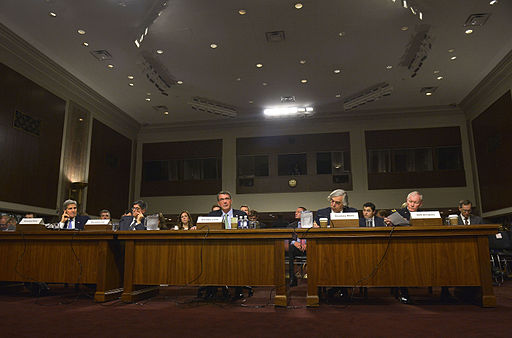‘Detention without trial is an affront to justice wherever it takes place’
By Sarah Lazare, staff writer for Common Dreams. Published 8-28-2015.

Secretary of Defense Ash Carter,center, testifies before the Senate Armed Services Committee. Photo public domain via Wikimedia Commons
As the administration of President Barack Obama publicly floats the possibility of opening a “Guantánamo North” on U.S. soil, rights campaigners warn that a mere transfer of the men and boys to another prison across national borders will not rectify the grave human rights violations committed against them.
“The Obama administration has its priorities in the wrong place,” Omar Shakir, a Center for Constitutional Rights fellow and attorney who represents detainees, told Common Dreams.
“Out of the 116 men and boys in Guantánamo, nearly 100 have either been approved for transfer or are waiting for a periodic review board to review their status for clearance,” Shakir continued. “They need to be released or charged and afforded full due process rights in a U.S. federal court.”
The administration, which has so far failed to deliver on Obama’s 2008 pledge to shutter the notorious facility, is now weighing the possibility of moving some of those men to U.S. prisons, or—as Carol Rosenberg of the Miami Herald reported Thursday—potentially building an entirely new detention center. Such a move would require Congress to lift its ban on transferring the men to the United States.
In addition to exploring potential prisons in Kansas and South Carolina, the Pentagon is considering other locations across the country, reported Rosenberg, citing an unnamed source in the Department of Defense.
“We’re working with the inter agency [other government departments] to come up with some other ideas, some other places we’ll visit,” said the source. “Of course, Gitmo was built on a place where there was no detention facility. So there is the option of what you could call a greenfield at a location where there is nothing now.”
Other officials, however, have gone on the record to drum up support.
Last week, Secretary of Defense Ash Carter championed Guantánamo North to reporters as a pathway for shuttering the facility. And the Pentagon said earlier this month that it is planning to submit a proposal to Congress relating to the closure of the facility in Cuba, allegedly at some point following the end of the August recess.
The U.S. has long claimed that the location of the Guantánamo prison allows them to detain “War On Terror” prisoners without granting them due process or legal protections, including those against torture.
Rights campaigners say that a mere relocation of the prison to the U.S. will not in itself correct this larger injustice—and therefore fails to honor the spirit of Obama’s 2008 pledge to shut down the prison over human rights concerns.
“Guantánamo the first time around was an unadulterated disaster, and the idea of simply moving it from the Caribbean to US soil would be laughable if it weren’t so despicable,” said Katie Taylor, deputy director of the Guantanamo team at the legal charity Reprieve, in a press statement released Friday. “Detention without trial is an affront to justice wherever it takes place.”
“There are countries ready and able to accept detainees who have been cleared and it is on this that the US administration must place their focus,” Taylor continued. “Guantánamo should never have been opened, and if Obama doesn’t want it to haunt his legacy he must fulfill his initial promise and close it once and for all.”
Ramzi Kassem, a professor at the City University of New York School of Law who has represented 14 people incarcerated at the facility, agrees. “Guantánamo was never a single prison facility,” he wrote earlier this week. “From the beginning, it was always an idea, an ideology that purportedly liberated the US government from the fetters of domestic and international law. It also formed part of a larger, global network of shady and lawless prisons set up by the United States after the 9/11 attacks.”
Obama’s plan is already meeting opposition from the right, with some lawmakers claiming that the transfer of the men and boys to a U.S. prison will somehow make those communities less safe.
In contrast, Shakir of the Center for Constitutional Rights argued for a third position, that honors the basic obligation to respect the human rights of the men held at the prison.
“Guantánamo is not simply the location of a prison,” said Shakir. “It speaks to a larger set of unlawful practices over 14 years, including holding men and boys in arbitrary detention year after year, holding many in solitary confinement even though they have been cleared for release. That is really the bottom line. If you simply transfer to another facility but continue to hold them arbitrarily and indefinitely, it really isn’t getting us very far.”
This work is licensed under a Creative Commons Attribution-Share Alike 3.0 License

